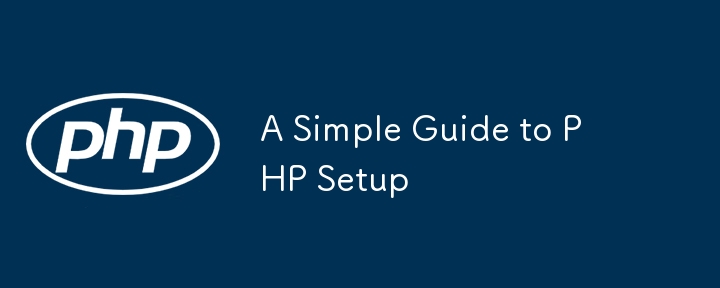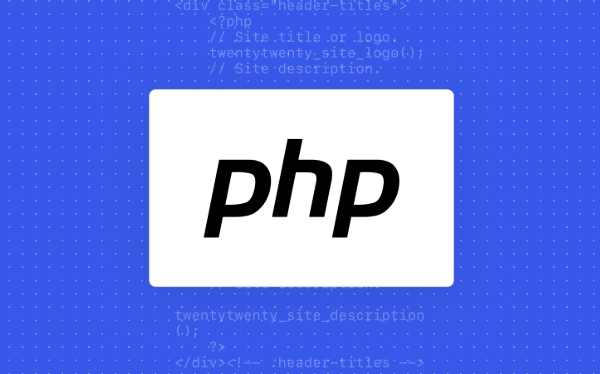A Simple Guide to PHP Setup
The key to setting up PHP is to clarify the installation method, configure php.ini, connect to the web server and enable necessary extensions. 1. Install PHP: Use apt for Linux, Homebrew for Mac, and XAMPP recommended for Windows; 2. Configure php.ini: adjust error reports, upload restrictions, etc. and restart the server; 3. Use web server: Apache to use mod_php, Nginx to use PHP-FPM; 4. Install commonly used extensions: such as mysqli, json, mbstring, etc. to support full functions.

PHP settings are actually not that complicated, but novices are always confused by various configurations at the beginning. In fact, as long as you understand a few key points, the basic environment will be able to run quickly. Let’s start from common needs and talk about how to solve the basic settings of PHP step by step.

Install PHP: Selecting the right method is easier
There are several ways to install PHP, the most common one is to install it through the package manager, or download the source code from the official website to compile it. If you are using Linux, such as Ubuntu, you can install it directly using apt :
sudo apt update sudo apt install php
Mac users can use Homebrew:

brew install php
It is recommended to use integrated environments such as XAMPP or WAMP on Windows to save the hassle of manual configuration. No matter which way, the key is to confirm whether PHP is installed successfully. You can use the following command to check the version:
php -v
As long as you can see the version number, the installation has been completed.

Configuring PHP environment: Don't ignore php.ini
After installing PHP, the next step is to configure the php.ini file. This is the main configuration file of PHP, which controls key functions such as error reporting, upload restrictions, extended loading, etc.
To find the location of this file, you can use:
php --ini
Common settings include:
-
error_reporting: It is recommended to set it toE_ALLduring the debugging phase to facilitate discovery of problems. -
display_errors: The development environment can be opened, but the production environment must be closed. -
upload_max_filesizeandpost_max_size: If you want to upload a file, these two values may need to be increased.
After changing the configuration, don't forget to restart the server, such as Apache or Nginx, the changes will take effect.
With web server: How to connect PHP and Apache/Nginx
To run PHP, it also needs to be equipped with a web server. The most common ones are Apache and Nginx.
Apache usually uses mod_php to handle PHP requests, and it will generally be automatically configured during installation. To test whether it takes effect, you can create a new info.php file:
<?php phpinfo(); ?>
If you can see the PHP detailed information page when accessing this file, it means that Apache and PHP are connected.
Nginx handles PHP requests through PHP-FPM. After installing PHP, remember to install php-fpm and then add FastCGI settings to the Nginx configuration file. This part is a little more complicated, but there are many standard configuration templates available for reference on the Internet.
Extensions and Dependencies: Don't forget to install commonly used modules
Many of PHP's functions are implemented through extensions. For example, if you need to connect to a database, you need to use mysqli or pdo_mysql , and if you need to use json extensions to handle json . The installation method is generally:
sudo apt install php-mysql
Or uncomment the corresponding extension in php.ini . Some frameworks such as Laravel also rely on mbstring , xml , curl and other modules. Remember to check whether they are enabled after installation.
Basically that's it. Setting up a PHP environment seems to have many steps, but as long as you take it step by step, it is actually not complicated. The key is to choose the appropriate installation method and configuration according to your use scenario, and don’t ignore the default settings. Many problems lie here.
The above is the detailed content of A Simple Guide to PHP Setup. For more information, please follow other related articles on the PHP Chinese website!

Hot AI Tools

Undress AI Tool
Undress images for free

Undresser.AI Undress
AI-powered app for creating realistic nude photos

AI Clothes Remover
Online AI tool for removing clothes from photos.

Clothoff.io
AI clothes remover

Video Face Swap
Swap faces in any video effortlessly with our completely free AI face swap tool!

Hot Article

Hot Tools

Notepad++7.3.1
Easy-to-use and free code editor

SublimeText3 Chinese version
Chinese version, very easy to use

Zend Studio 13.0.1
Powerful PHP integrated development environment

Dreamweaver CS6
Visual web development tools

SublimeText3 Mac version
God-level code editing software (SublimeText3)

Hot Topics
 A Simple Guide to PHP Setup
Jul 18, 2025 am 04:25 AM
A Simple Guide to PHP Setup
Jul 18, 2025 am 04:25 AM
The key to setting up PHP is to clarify the installation method, configure php.ini, connect to the web server and enable necessary extensions. 1. Install PHP: Use apt for Linux, Homebrew for Mac, and XAMPP recommended for Windows; 2. Configure php.ini: Adjust error reports, upload restrictions, etc. and restart the server; 3. Use web server: Apache uses mod_php, Nginx uses PHP-FPM; 4. Install commonly used extensions: such as mysqli, json, mbstring, etc. to support full functions.
 Tips for Writing PHP Comments
Jul 18, 2025 am 04:51 AM
Tips for Writing PHP Comments
Jul 18, 2025 am 04:51 AM
The key to writing PHP comments is to clarify the purpose and specifications. Comments should explain "why" rather than "what was done", avoiding redundancy or too simplicity. 1. Use a unified format, such as docblock (/*/) for class and method descriptions to improve readability and tool compatibility; 2. Emphasize the reasons behind the logic, such as why JS jumps need to be output manually; 3. Add an overview description before complex code, describe the process in steps, and help understand the overall idea; 4. Use TODO and FIXME rationally to mark to-do items and problems to facilitate subsequent tracking and collaboration. Good annotations can reduce communication costs and improve code maintenance efficiency.
 Quick PHP Installation Tutorial
Jul 18, 2025 am 04:52 AM
Quick PHP Installation Tutorial
Jul 18, 2025 am 04:52 AM
ToinstallPHPquickly,useXAMPPonWindowsorHomebrewonmacOS.1.OnWindows,downloadandinstallXAMPP,selectcomponents,startApache,andplacefilesinhtdocs.2.Alternatively,manuallyinstallPHPfromphp.netandsetupaserverlikeApache.3.OnmacOS,installHomebrew,thenrun'bre
 Commenting Out Code in PHP
Jul 18, 2025 am 04:57 AM
Commenting Out Code in PHP
Jul 18, 2025 am 04:57 AM
There are three common methods for PHP comment code: 1. Use // or # to block one line of code, and it is recommended to use //; 2. Use /.../ to wrap code blocks with multiple lines, which cannot be nested but can be crossed; 3. Combination skills comments such as using /if(){}/ to control logic blocks, or to improve efficiency with editor shortcut keys, you should pay attention to closing symbols and avoid nesting when using them.
 Learning PHP: A Beginner's Guide
Jul 18, 2025 am 04:54 AM
Learning PHP: A Beginner's Guide
Jul 18, 2025 am 04:54 AM
TolearnPHPeffectively,startbysettingupalocalserverenvironmentusingtoolslikeXAMPPandacodeeditorlikeVSCode.1)InstallXAMPPforApache,MySQL,andPHP.2)Useacodeeditorforsyntaxsupport.3)TestyoursetupwithasimplePHPfile.Next,learnPHPbasicsincludingvariables,ech
 Mastering PHP Block Comments
Jul 18, 2025 am 04:35 AM
Mastering PHP Block Comments
Jul 18, 2025 am 04:35 AM
PHPblockcommentsareusefulforwritingmulti-lineexplanations,temporarilydisablingcode,andgeneratingdocumentation.Theyshouldnotbenestedorleftunclosed.BlockcommentshelpindocumentingfunctionswithPHPDoc,whichtoolslikePhpStormuseforauto-completionanderrorche
 Writing Effective PHP Comments
Jul 18, 2025 am 04:44 AM
Writing Effective PHP Comments
Jul 18, 2025 am 04:44 AM
Comments cannot be careless because they want to explain the reasons for the existence of the code rather than the functions, such as compatibility with old interfaces or third-party restrictions, otherwise people who read the code can only rely on guessing. The areas that must be commented include complex conditional judgments, special error handling logic, and temporary bypass restrictions. A more practical way to write comments is to select single-line comments or block comments based on the scene. Use document block comments to explain parameters and return values at the beginning of functions, classes, and files, and keep comments updated. For complex logic, you can add a line to the previous one to summarize the overall intention. At the same time, do not use comments to seal code, but use version control tools.
 Improving Readability with Comments
Jul 18, 2025 am 04:46 AM
Improving Readability with Comments
Jul 18, 2025 am 04:46 AM
The key to writing good comments is to explain "why" rather than just "what was done" to improve the readability of the code. 1. Comments should explain logical reasons, such as considerations behind value selection or processing; 2. Use paragraph annotations for complex logic to summarize the overall idea of functions or algorithms; 3. Regularly maintain comments to ensure consistency with the code, avoid misleading, and delete outdated content if necessary; 4. Synchronously check comments when reviewing the code, and record public logic through documents to reduce the burden of code comments.







